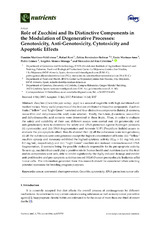Mostrar el registro sencillo del ítem
Role of Zucchini and Its Distinctive Components in the Modulation of Degenerative Processes: Genotoxicity, Anti-Genotoxicity, Cytotoxicity and Apoptotic Effects
| dc.contributor.author | Martínez Valdivieso, Damián | |
| dc.contributor.author | Font, Rafael | |
| dc.contributor.author | Fernández Bedmar, Zahira Noemí | |
| dc.contributor.author | Merinas Amo, María Tania | |
| dc.contributor.author | Gómez, Pedro | |
| dc.contributor.author | Alonso Moraga, Ángeles | |
| dc.contributor.author | Río-Celestino, Mercedes del | |
| dc.date.accessioned | 2018-01-24T13:25:18Z | |
| dc.date.available | 2018-01-24T13:25:18Z | |
| dc.date.issued | 2017 | |
| dc.identifier.uri | http://hdl.handle.net/10396/15975 | |
| dc.description.abstract | Zucchini (Cucurbita pepo subsp. pepo) is a seasonal vegetable with high nutritional and medical values. Many useful properties of this fruit are attributed to bioactive compounds. Zucchini fruits (“Yellow” and “Light Green” varieties) and four distinctive components (lutein, -carotene, zeaxanthin and dehydroascorbic acid) were selected. Firstly, the lutein, -carotene, zeaxanthin and dehydroascorbic acid contents were determined in these fruits. Then, in order to evaluate the safety and suitability of their use, different assays were carried out: (i) genotoxicity and anti-genotoxicity tests to determine the safety and DNA-protection against hydrogen peroxide; (ii) cytotoxicity; and (iii) DNA fragmentation and Annexin V/PI (Propidium Iodide) assays to evaluate the pro-apoptotic effect. Results showed that: (i) all the substances were non-genotoxic; (ii) all the substances were anti-genotoxic except the highest concentration of lutein; (iii) “Yellow” zucchini epicarp and mesocarp exhibited the highest cytotoxic activity (IC50 > 0.1 mg/mL and 0.2 mg/mL, respectively); and (iv) “Light Green” zucchini skin induced internucleosomal DNA fragmentation, -carotene being the possible molecule responsible for its pro-apoptotic activity. To sum up, zucchini fruit could play a positive role in human health and nutrition due to this fruit and its components were safe, able to inhibit significantly the H2O2-induced damage and exhibit anti-proliferative and pro-apoptotic activities toward HL60 (human promyelocytic leukemia cells) tumor cells. The information generated from this research should be considered when selecting potential accessions for breeding program purposes. | es_ES |
| dc.format.mimetype | application/pdf | es_ES |
| dc.language.iso | eng | es_ES |
| dc.publisher | MDPI | es_ES |
| dc.rights | https://creativecommons.org/licenses/by/4.0/ | es_ES |
| dc.source | Nutrients 9(7), 755 (2017) | es_ES |
| dc.subject | Cancer | es_ES |
| dc.subject | Carotenoid | es_ES |
| dc.subject | Chemoprevention | es_ES |
| dc.subject | Cucurbita | es_ES |
| dc.subject | Cytotoxicity | es_ES |
| dc.subject | DNA-protection | es_ES |
| dc.subject | Tumor cells | es_ES |
| dc.title | Role of Zucchini and Its Distinctive Components in the Modulation of Degenerative Processes: Genotoxicity, Anti-Genotoxicity, Cytotoxicity and Apoptotic Effects | es_ES |
| dc.type | info:eu-repo/semantics/article | es_ES |
| dc.relation.publisherversion | http://dx.doi.org/10.3390/nu9070755 | es_ES |
| dc.relation.projectID | Gobierno de España. RTA2014-00078-00-00 | es_ES |
| dc.relation.projectID | Unión Europea. FEDER 2014-2020 | |
| dc.rights.accessRights | info:eu-repo/semantics/openAccess | es_ES |

